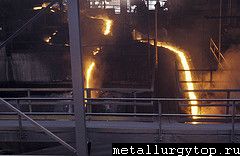Alloying Elements in Titanium
 In the solid state, the titanium alloys are arranged in either hexagonal close–packed (alpha) or body–centered cubic (beta) structure. Pure titanium undergoes an allotropic transformation from hexagonal close–packed (HCP) alpha titanium to body–centered cubic (BCC) beta titanium as its temperature is raised through 882 °C (1620 °F). The melting point of pure titanium is 1668 °C (3034 °F).
In the solid state, the titanium alloys are arranged in either hexagonal close–packed (alpha) or body–centered cubic (beta) structure. Pure titanium undergoes an allotropic transformation from hexagonal close–packed (HCP) alpha titanium to body–centered cubic (BCC) beta titanium as its temperature is raised through 882 °C (1620 °F). The melting point of pure titanium is 1668 °C (3034 °F).
Aluminum is the most widely used alloying element in titanium–based alloys. It is the only common metal that raises the beta transus temperature and have large solubilities in both the alpha and beta phases.
Elements such as aluminum, oxygen, nitrogen, carbon, gallium, germanium, lanthanum, and cerium stabilize the alpha phase to higher temperature and are thus referred to as alpha stabilizers.
In general, transition metals and noble metals (i.e., metals which, like titanium, have unfilled or just–filled d–electron bands) are stabilizers of the beta phase to lower temperatures and are thus referred to as beta stabilizers.
Beta stabilizers are subdivided into two groups: beta–isomorphous (e.g. vanadium, niobium, tantalum, molybdenum, and rhenium) and beta–eutectoid (e.g., copper, silver, gold, palladium, indium, lead, bismuth, chromium, tungsten, manganese, iron, cobalt, nickel, uranium, hydrogen, and silicon).
Vanadium, molybdenum, and niobium are the most frequently used beta–isomorphous forming elements in titanium–based alloys. These elements, when added in sufficient concentrations, can stabilize the beta phase to room temperature. Tantalum and rhenium, which are also beta–isomorphous forming elements, are rarely used, mainly due to their high densities.
Chromium, iron, and silicon are the only beta–eutectoid forming elements that are commonly used in many titanium–based alloys.
Zirconium, hafnium, and tin form a group of alloying elements known as neutral additions. These three elements are sometimes classified as beta stabilizers, as they depress the beta transus temperature (albeit only slightly) in their respective binary phase diagrams with titanium. Zirconium and hafnium are isomorphous with titanium and exhibit the same beta to alpha allotropic phase transformations. These two elements have complete solubilities in the alpha and beta phases of titanium. Tin is a beta–eutectoid forming element and its effect on the beta transus temperature is negligible for all practical purposes.
When added to alpha–matrix alloys, however, neutral additions such as zirconium and tin can take on the characteristics of alpha stabilizers (e.g., aluminum). This is because of the chemical similarity of zirconium to titanium and because tin can substitutionally replace aluminum in the Ti3Al phase.





Рейтинг популярности - на эти заметки чаще ссылаются:
- 43 Герой социалистического труда
- 42 Известный телеведущий целую неделю снимал о Южном Урале
- 41 Первый чугун на каменном угле
- 39 Механизация очистки горновых канав
- 38 Замена конвейерных лент
- 36 Отработка верхнего шлака
- 34 Безотходное производство чугуна
- 33 Металлургия России: всем выйти из кризиса Читать полностью:
- 33 Ремонты чугунных и шлаковых канав
- 33 Системы программного управления